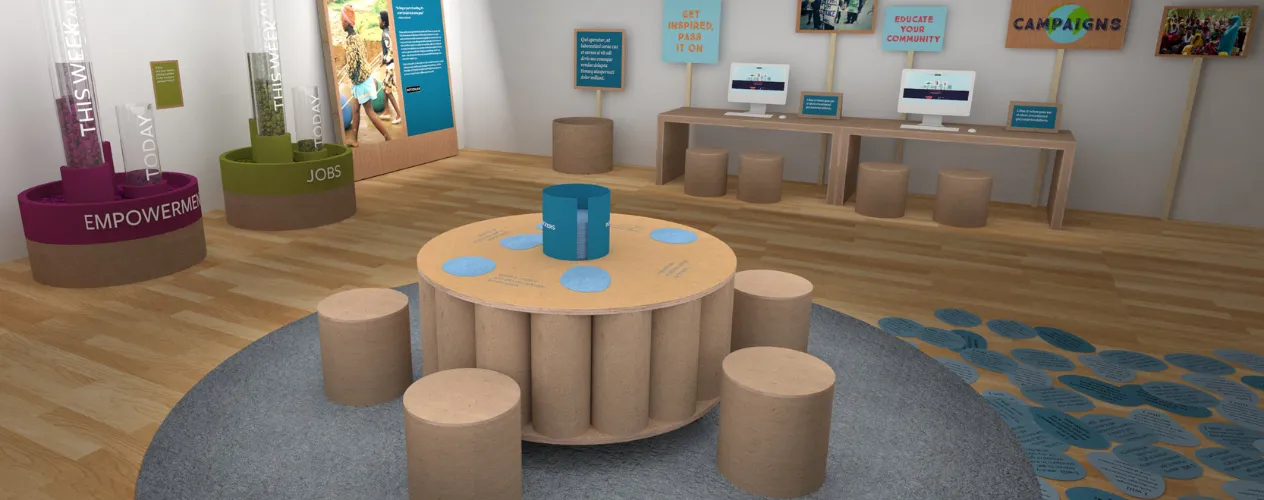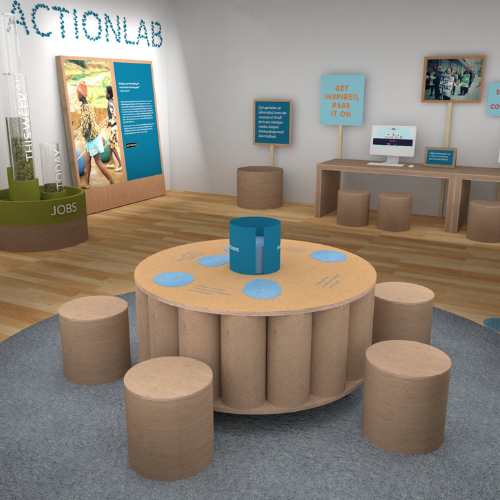A PATH APPEARS: Actions for a Better World | Opens November 19
The Skirball's guest curator for A PATH APPEARS: Actions for a Better World is FSPH adjunct professor, Neal Baer, and will feature ActionLab.org.

Skirball Cultural Center unveils details about upcoming exhibition.
A PATH APPEARS
Actions for a Better World
November 19, 2015–February 21, 2016
Opening event to feature A Path Appears co-author Sheryl WuDunn
in conversation with guest curator Neal Baer.
wHY and C&G Partners collaborate on innovative gallery design.
LOS ANGELES, CA—The Skirball Cultural Center announces new information about its next major exhibition, A Path Appears: Actions for a Better World, opening November 19, 2015. Designed to inspire visitors to find their own paths to making a difference in the world, the exhibition will explore four critical humanitarian issues—education, health, jobs, and empowerment—and reveal how organizations, both local and global, are developing workable solutions to these worldwide challenges. Through ActionLab, a mobile-friendly tool that uses storytelling to turn inspiration into action, the exhibition will culminate in recommending practical, results-driven steps that visitors can take to bring about social change.
To mark the opening of the exhibition, the Skirball will present a public program featuring Pulitzer Prize–winning journalist Sheryl WuDunn; it will take place on Tuesday, November 17, at 8:00 p.m. The exhibition is inspired by and named after WuDunn’s bestselling book A Path Appears (Knopf, 2014), co-authored by New York Times journalist Nicholas D. Kristof and praised by President Bill Clinton as “an inspiring roundup of the many simple and efficient ways in which we can lend our hearts and talents to grow hope and opportunity at home and around the globe.” In a conversation moderated by the exhibition’s guest curator, Neal Baer, WuDunn will address the art and science of giving, identify successful local and global initiatives, and share compelling stories from the front lines of social progress.
A Path Appears is presented in cooperation with Show of Force, and with the WORLD Policy Analysis Center and the Global Media Center for Social Impact at the UCLA Fielding School of Public Health. Both centers at UCLA have provided expert guidance during the development of the exhibition.
Creating the Experience
To advance the ideas presented in WuDunn and Kristof’s book, the Skirball teamed up with Baer, a pediatrician and Emmy-nominated writer and producer (ER, Law & Order: SVU, Under the Dome), well known for combining his background in medicine and storytelling to promote social change. Baer is adjunct professor at the UCLA Fielding School of Public Health and the co-founder of the Fielding School’s Global Media Center for Social Impact.
Baer remarks, “I’m thrilled to help bring an innovative approach to storytelling to the Skirball with the exhibition A Path Appears. We have brought together a unique team—led by the Skirball—to provide visitors with a memorable experience that we hope will inspire them to take action to promote social change.”
The Skirball turned to the designers at wHY and C&G Partners to create the environment for the exhibition. In their first-ever collaboration, the award-winning firms embraced the challenge of developing a gallery installation that was also a community engagement project. Working closely with leading exhibit fabrication firm Cinnabar, they have pursued what they describe as “a low-tech, high-charm approach” to A Path Appears.
Jonathan Alger, co-founder and partner at C&G Partners, observes, “This is a new and exciting process in exhibition design. Rather than design a static experience, we offer an open-source prototype for bringing about social change and ask visitors to take action to help shape the exhibition. Visitors are just as much our collaborators in this process as the curators, architects, and fabricators, making the outcome that much more innovative and inspiring.”
Bob Dornberger, the leader of wHY’s Objects Workshop, explains, “Our design philosophy, using humble materials that were on the way to the landfill, paired with a low-tech process of sketching and prototyping, resulted in four engaging pavilions to inspire wonder.”
wHY’s founder, Kulapat Yantrasast, adds, “Our concept is to make an enabling experience, in every sense of the word—experience that is open-source, free to roam, and hopefully encourages people to take action.”
Gallery Walkthrough
At the entrance to the exhibition, visitors discover the inspiration for the book and exhibition title, a 1921 passage by Chinese essayist Lu Xun: “Hope is like a path in the countryside. Originally there is nothing, but as people walk this way again and again, a path appears.” An introductory video by Show of Force—which produced the three-part PBS documentary A Path Appears, also based on Kristof and WuDunn’s book—orients visitors to the exhibition’s four themes. A path of blue pebble-shaped stickers on the floor hints at a visitor activity to be revealed later in the gallery.
Upon entering the gallery, visitors encounter innovatively designed “pavilions,” each focused on a different theme and constructed from a different repurposed material. Every themed pavilion sheds light on the successes of select non-governmental organizations, including several based in Southern California.
Education—The first pavilion addresses the subject of education through photomurals and storybooks. These highlight eight individuals or groups that have successfully improved educational outcomes in the United States and worldwide. Visitors are urged to consider how accessible, quality education impacts not cognitive development, but also a child’s health and economic opportunity. Maps provided by the WORLD Policy Analysis Center at the Fielding School vividly illustrate where education is free and compulsory around the world; and reveal how combating child labor and child marriage can help ensure that young people complete their education.
The education pavilion is defined physically by a structure crafted from thousands of pages of recycled newspapers, representing literacy. As in the rest of the gallery, seating areas in the pavilion invite visitors to gather and discuss the issues.
Health—In the next pavilion, visitors examine inexpensive innovations in healthcare that have the potential to do the most good for the most people according to experts in the field. On display are several products that are helping to solve global healthcare challenges such as disease prevention, access to clean water, nutrition, and maternal and neonatal care. Among these is the Hippo Roller, a large plastic drum on wheels that rural dwellers can fill with water for easy transport across rough terrain. Maps from the WORLD Policy Analysis Center illustrate pertinent topics, including whether constitutions around the world guarantee a citizen’s health rights.
Symbolizing the protection that good healthcare provides, “clouds” of bubble wrap hang above the health pavilion. These transparent plastic shapes are illuminated from the inside by warm, pulsing light, reminiscent of the pattern of breathing.
Jobs—The pavilion focusing on employment features media stations. Here visitors access stories revealing how good jobs and fair wages are essential for creating equal opportunity and overcoming poverty. Topics range from microfinance to workplace discrimination to job creation, with emphasis on how livable working conditions for the labor force lead to the economic security of the total population. Maps from the WORLD Policy Analysis Center address the complex issue of paid family and sick leave.
In a nod to the audio experience that characterizes the jobs section, the pavilion will feature tall curving structures made from approximately 6,000 used CDs.
Empowerment—The pavilion on empowerment will feature trailers from nine feature documentaries depicting grassroots efforts to advance equality around the world. These include such films as He Named Me Malala, addressing equal access to education for girls and women; and Made in L.A., focusing on labor protections in the Los Angeles garment industry. A map from the WORLD Policy Analysis Center portrays whether constitutions around the world take at least one approach to equity on the basis of gender, ethnicity, religion, and/or disability.
To view these film trailers, visitors gather in a small, immersive theater setting, with walls assembled from 120 recycled car tires.
ActionLab—The final zone of the gallery invites visitors to choose what has inspired them most in the exhibition and to learn practice-proven methods for effecting change. Here they log onto ActionLab.org, a project of the Global Media Center for Social Impact at the Fielding School that has been conceived and created by Baer. For every story or organization featured in the exhibition, the platform will suggest a direct, concrete action, such as signing up to mentor a highly motivated, underserved student from South L.A. through the organization South Central Scholars; or rallying two friends to volunteer with Chrysalis, assisting the L.A. organization’s clients to prepare resumes and practice for job interviews.
In this final zone, visitors are also encouraged to make a written pledge to the cause of their choice on a blue pebble-shaped sticker. As visitors add more and more pledges to the floor in the gallery, the shape of a path becomes better defined: a path appears.
On selected days throughout the run of the exhibition, visitor participation will be facilitated further through in-gallery talks led by experts from featured local organizations. Representatives from South Central Scholars, Border Angels, and Chrysalis, among others, will provide first-hand accounts of how they have improved conditions for underserved communities and advise visitors on how they, too, can make a difference.
A PATH APPEARS: ACTIONS FOR A BETTER WORLD IS MADE POSSIBLE IN PART BY GENEROUS SUPPORT FROM:
The Angell Foundation
Neal Baer
The California Wellness Foundation
Edna McConnell Clark Foundation
Joan and Jerry Doren
Suzanne Lerner/Michael Stars Foundation
The Eileen Harris Norton Foundation
Sidhu-Singh Family Foundation
Phoebe Snow Foundation
Dick Wolf
MEDIA SPONSOR:
89.3 KPCC FM
About the Skirball
The Skirball Cultural Center is dedicated to exploring the connections between 4,000 years of Jewish heritage and the vitality of American democratic ideals. It welcomes and seeks to inspire people of every ethnic and cultural identity. Guided by our respective memories and experiences, together we aspire to build a society in which all of us can feel at home. The Skirball Cultural Center achieves its mission through educational programs that explore literary, visual, and performing arts from around the world; through the display and interpretation of its permanent collections and changing exhibitions; through an interactive family destination inspired by the Noah’s Ark story; and through outreach to the community.
Visiting the Skirball
The Skirball Cultural Center is located at 2701 N. Sepulveda Blvd., Los Angeles, CA 90049. Museum hours: Tuesday–Friday 12:00–5:00 p.m.; Saturday–Sunday 10:00 a.m.–5:00 p.m.; closed Mondays and holidays. Admission to exhibitions: $10 General; $7 Seniors, Full-Time Students, and Children over 12; $5 Children 2–12. Exhibitions are always free to Skirball Members and Children under 2. Exhibitions are free to all visitors on Thursdays. For general information, the public may call (310) 440-4500 or visit skirball.org. The Skirball is also home to Zeidler’s Café, which serves innovative California cuisine in an elegant setting, and Audrey’s Museum Store, which sells books, contemporary art, music, jewelry, and more.
